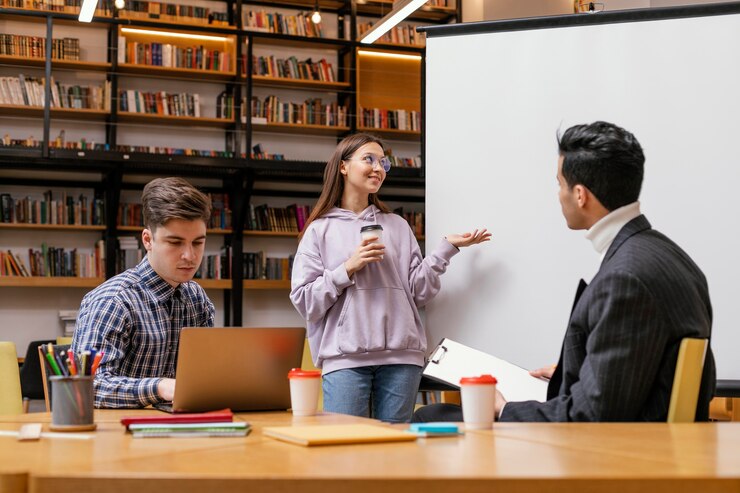
To help out students effectively, the conventional master’s program is no longer in place. Many contemporary graduate students are looking for more individualized support, real-world application of principles, and flexible learning alternatives to fit their hectic schedules.
Thankfully, a new generation of creative master class models is starting to emerge to address these changing demands better. The online class help services programs are transforming what it means to pursue further education, offering multiple benefits to students. In this post, we will look into those features that today’s master’s class is providing students to help them!
Cross-over Learning
The concept of “crossover learning” making connections between academic material and experiences outside of the classroom fits in nicely with the cutting-edge methods that are appearing in contemporary master’s programs.
Many of these new master’s degree programs provide chances for experiential learning that let students use what they’ve learned in the classroom to work on real-world projects. For instance, students in mentor-driven master’s programs frequently collaborate on real-world client engagements with mentors from the business. The intersection between the classroom and the workplace broadens students’ perspectives and generates new research issues.
Flipped Classrooms
The new generation of master’s programs created to better serve today’s graduate students combines essential ideas with the flipped classroom model, which flips the traditional teaching method.
A flipped classroom lets students study at their speed by delivering educational information online outside of scheduled class times. Similar to this, a lot of cutting-edge master’s programs make use of adaptable, hybrid learning methods that enable students to access course materials online and at their own pace. This gives students the freedom to interact with the material at a time and in a way that suits their learning preferences and schedules.
Galynska, O., Shkoliar, N., Dziubata, Z., Kravets, S., & Levchyk, N. (2021).
Here is a chart that helps you differentiate between a flipped classroom and a traditional classroom:
Using Online Resources
Cutting-edge master’s programs are using the internet more and more to create life-changing educational opportunities. By allowing students to access educational information digitally outside of class, this approach frees up critical in-person time for discussions, active participation, and hands-on application of concepts. The prospects for experiential learning are increased by the availability of guest lecturers, virtual field visits, and interactive case studies through online platforms.
If I were to do my online masters class help, I would choose reliable online or even e-learning platforms. Personalized learning paths are made possible by adaptive learning technology and real-time feedback, which also give teachers data-driven insights to help them improve their instruction over time. These online platforms master’s programs provide students with the information, abilities, and self-directed learning mentality they need to succeed in the contemporary workplace by seamlessly incorporating online resources.
(bestassignmentwriter,2019)
Use Of Social Media
Social media and teamwork technologies may greatly improve the educational process and encourage more communication between various student groups.
For instance, Slack and similar technologies offer a unified platform for easy-to-use communication, feedback, and activity summaries across several social media networks. This makes it easier for students to participate in debates, exchange information, and remain in touch, which fosters a greater feeling of community and teamwork.
Likewise, content curation websites such as Scoop. It helps students to find, arrange, and communicate pertinent knowledge and ideas about their courses and interests. This not only fosters critical thinking but also self-directed learning.
Using Podcasts
Instructors can make multi-media podcasts to enhance course units or subjects, give students feedback on their work, or condense lectures into summaries that students can listen to and review. Students summarize readings or lectures as study aids for other students, teach or explain concepts, go over problem-solving techniques in depth, or construct a project as a service-learning or public engagement activity.
All of these things are done in student-produced podcasts. Teachers should provide audiovisual content for learning “on demand,” anywhere, at any time. For example, they could make lessons and guidelines for students’ homework and test revisions available to parents and students at their convenience.
Managing Personal Blogs
Innovative master’s programs can effectively expand academic debates outside of the classroom by incorporating a private class blog or wiki. Students may use this digital platform to practice professional communication skills, share pertinent thoughts and resources, and go deeper into the course material. Peer-to-peer knowledge sharing is encouraged by the dynamic flow of ideas made possible by the interactive comment section and collaborative capabilities.
Additionally, the constant communication in this encouraging setting helps students develop their social and emotional intelligence, which is crucial for success in the contemporary workplace. Master’s programs can enable students to take charge of their education and build the multifarious skills necessary to succeed in their future employment by fostering a thriving online learning community.
Brainstorming
Students are forced to modify their prior knowledge, make room for new information, and sharpen their awareness through this cooperative process. Master’s students get a greater comprehension of the subject matter and improve critical thinking, creativity, and communication skills by talking about their ideas and hearing different points of view.
One of the most important functions of brainstorming sessions in an innovative master’s program is to show students that their contributions, expertise, and language skills are recognized and appreciated. This encourages students to take chances, have thoughtful conversations, and actively contribute to the co-creation of knowledge all of which are essential for their growth on the personal and professional fronts.
Conclusion:
Today’s master’s degree student has access to a wide range of cutting-edge resources and methods that go well beyond the conventional lecture hall. These developments not only improve the educational process but also equip students to face the difficulties of a world that is changing quickly and the intricacies of the modern workforce.